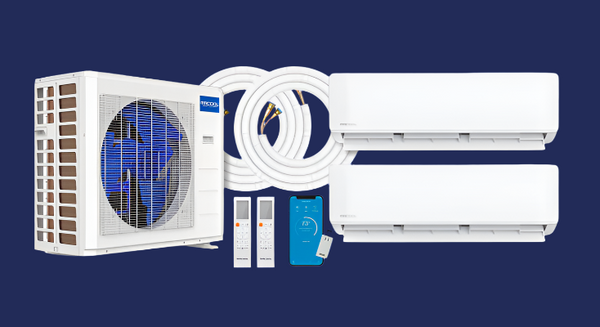How Mini-Split Systems Generate Heat: A Complete Guide to Heat Pump Technology
Mini-split systems use advanced heat pump technology to efficiently heat and cool spaces. Unlike traditional heating methods that rely on burning fuel (like gas or oil), mini-split heat pumps work by transferring heat rather than creating it. This results in lower energy consumption, reduced heating costs, and a more environmentally friendly solution.
Whether you’re looking to upgrade your home’s heating system or want to understand how mini-split units function in colder climates, this guide provides a detailed breakdown of how mini-splits generate heat and why they’re an efficient choice for year-round comfort.
How a Mini-Split System Heats Your Home
A mini-split heat pump operates using a closed-loop refrigerant cycle, which allows it to extract heat from outdoor air—even in cold temperatures—and transfer it indoors. Here’s a step-by-step breakdown of how this process works:
1. Refrigerant Cycle: The Heart of the System
At the core of every mini-split system is a continuous refrigerant cycle, which is responsible for moving heat between the indoor and outdoor units. This cycle consists of four key components:
- Compressor – Pressurizes and circulates the refrigerant.
- Condenser Coil (Outdoor Unit) – Extracts heat from the air.
- Expansion Valve – Controls the flow and pressure of the refrigerant.
- Evaporator Coil (Indoor Unit) – Releases heat into the home.
The refrigerant inside the system constantly absorbs, transports, and releases heat to maintain a comfortable indoor temperature.
2. Heat Extraction: Pulling Heat from Outdoor Air
In heating mode, the outdoor unit (condenser) works by extracting heat from the air, even in freezing conditions. While it may seem counterintuitive, air still contains thermal energy, even when temperatures drop below freezing.
🔹 How does this work?
- The outdoor coil absorbs heat from the surrounding air.
- The refrigerant inside the coil absorbs this heat, causing it to evaporate into a gas.
- This heat-laden refrigerant is then sent to the compressor.
Even in sub-zero temperatures, modern mini-splits are capable of extracting enough heat to warm your home effectively.
3. Compression & Heat Amplification
Once the refrigerant absorbs heat from the air, it travels to the compressor inside the outdoor unit. The compressor pressurizes the refrigerant, significantly raising its temperature in the process.
🔥 Why does compression increase heat?
- When gas is compressed, its temperature increases.
- The refrigerant, now a superheated gas, is ready to transfer heat indoors.
This is the key step that allows a mini-split system to generate warmth, even in low outdoor temperatures.
4. Heat Distribution: Warming Your Home
Once the heated refrigerant reaches the indoor unit (evaporator coil), it releases its heat into the air inside your home.
🔹 How does this happen?
- The indoor unit's fan blows air over the hot evaporator coil.
- The heat from the refrigerant is transferred to the air.
- The warm air is then circulated throughout the room, raising the indoor temperature.
As this process continues, the refrigerant returns to the outdoor unit, where it releases any excess heat and restarts the cycle.
5. Air Circulation: Consistent and Even Heating
Unlike traditional forced-air systems, mini-splits do not rely on ductwork. Instead, the indoor unit continuously circulates warm air, ensuring consistent heating without the energy loss associated with ducts.
✅ Benefits of ductless air circulation:
- More even heating across rooms.
- No heat loss through leaky ducts.
- Quieter operation compared to central heating systems.
Why Mini-Split Systems Are More Energy-Efficient
One of the biggest advantages of mini-split units is their exceptional energy efficiency. Unlike traditional furnaces or baseboard heaters, mini-splits move heat instead of generating it. This makes them significantly more efficient, especially in mild to moderate climates.
🔹 How mini-splits compare to other heating methods:
- Mini-split efficiency (300-400% COP) – Produces 3-4x more heat than the energy it consumes.
- Electric resistance heating (100% COP) – Converts all electricity into heat (less efficient).
- Gas furnaces (80-96% AFUE) – Lose some heat energy through exhaust.
💡 Key takeaway: Mini-splits use less energy to deliver more heat, leading to lower heating bills and reduced carbon emissions.
Mini-Splits in Cold Climates: Do They Work in Freezing Temperatures?
Mini-splits are designed to function efficiently in most climates, but extreme cold can impact performance. However, modern heat pump technology has made mini-splits much more capable of operating in sub-zero temperatures.
Cold-Climate Mini-Split Features
Some models come with advanced low-temperature enhancements, such as:
✔️ Hyper-Heat Technology – Designed for efficient operation in temperatures as low as -22°F.
✔️ Cold Weather Inverter Compressors – Prevents freezing and ensures consistent heating output.
✔️ Auxiliary Heat Strips – Provides backup heating support when temperatures drop too low.
If you live in an extremely cold region, choosing a high-performance cold-climate mini-split ensures reliable heating even in harsh winter conditions.
The Bottom Line: Why Choose a Mini-Split for Heating?
Mini-split heat pumps offer a versatile, energy-efficient, and environmentally friendly way to heat and cool your home. Unlike traditional heating systems, they use advanced heat transfer technology to deliver consistent warmth while consuming less energy.
✔️ Highly efficient heating and cooling year-round.
✔️ Lower energy costs compared to traditional heating systems.
✔️ Ductless design eliminates heat loss from ductwork.
✔️ Ideal for cold climates with low-temperature enhancements.
✔️ Eco-friendly operation reduces carbon footprint.
If you're looking for a cost-effective and sustainable way to heat your home, mini-split systems are the perfect solution.
Explore High-Efficiency Mini-Split Systems at MRCOOL DIY Direct
💨 Ready to upgrade your heating system? MRCOOL DIY Direct offers cutting-edge mini-split heat pumps designed for maximum efficiency and year-round comfort.
🔹 Shop now and find the perfect energy-efficient heating solution for your home!
📌 Visit www.mrcooldiydirect.com to explore our full range of mini-split systems.





